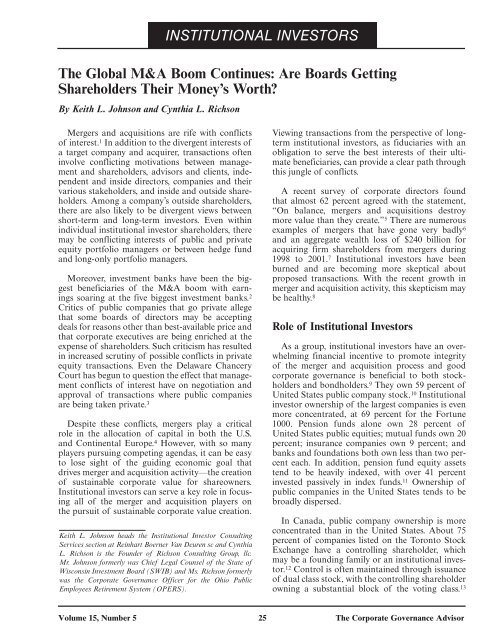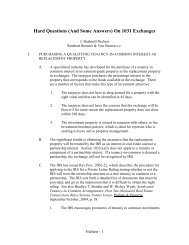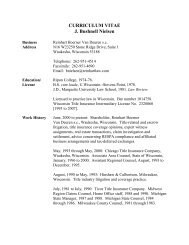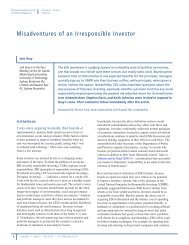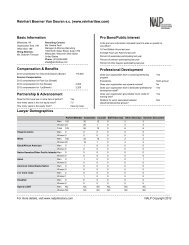Are Boards Getting Shareholders Their Money's Worth? - Reinhart ...
Are Boards Getting Shareholders Their Money's Worth? - Reinhart ...
Are Boards Getting Shareholders Their Money's Worth? - Reinhart ...
You also want an ePaper? Increase the reach of your titles
YUMPU automatically turns print PDFs into web optimized ePapers that Google loves.
The Global M&A Boom Continues: <strong>Are</strong> <strong>Boards</strong> <strong>Getting</strong><br />
<strong>Shareholders</strong> <strong>Their</strong> Money’s <strong>Worth</strong>?<br />
By Keith L. Johnson and Cynthia L. Richson<br />
INSTITUTIONAL INVESTORS<br />
Mergers and acquisitions are rife with conflicts<br />
of interest. 1 In addition to the divergent interests of<br />
a target company and acquirer, transactions often<br />
involve conflicting motivations between management<br />
and shareholders, advisors and clients, independent<br />
and inside directors, companies and their<br />
various stakeholders, and inside and outside shareholders.<br />
Among a company’s outside shareholders,<br />
there are also likely to be divergent views between<br />
short-term and long-term investors. Even within<br />
individual institutional investor shareholders, there<br />
may be conflicting interests of public and private<br />
equity portfolio managers or between hedge fund<br />
and long-only portfolio managers.<br />
Moreover, investment banks have been the biggest<br />
beneficiaries of the M&A boom with earnings<br />
soaring at the five biggest investment banks. 2<br />
Critics of public companies that go private allege<br />
that some boards of directors may be accepting<br />
deals for reasons other than best-available price and<br />
that corporate executives are being enriched at the<br />
expense of shareholders. Such criticism has resulted<br />
in increased scrutiny of possible conflicts in private<br />
equity transactions. Even the Delaware Chancery<br />
Court has begun to question the effect that management<br />
conflicts of interest have on negotiation and<br />
approval of transactions where public companies<br />
are being taken private. 3<br />
Despite these conflicts, mergers play a critical<br />
role in the allocation of capital in both the U.S.<br />
and Continental Europe. 4 However, with so many<br />
players pursuing competing agendas, it can be easy<br />
to lose sight of the guiding economic goal that<br />
drives merger and acquisition activity—the creation<br />
of sustainable corporate value for shareowners.<br />
Institutional investors can serve a key role in focusing<br />
all of the merger and acquisition players on<br />
the pursuit of sustainable corporate value creation.<br />
Keith L. Johnson heads the Institutional Investor Consulting<br />
Services section at <strong>Reinhart</strong> Boerner Van Deuren sc and Cynthia<br />
L. Richson is the Founder of Richson Consulting Group, llc.<br />
Mr. Johnson formerly was Chief Legal Counsel of the State of<br />
Wisconsin Investment Board (SWIB) and Ms. Richson formerly<br />
was the Corporate Governance Officer for the Ohio Public<br />
Employees Retirement System (OPERS).<br />
Viewing transactions from the perspective of longterm<br />
institutional investors, as fiduciaries with an<br />
obligation to serve the best interests of their ultimate<br />
beneficiaries, can provide a clear path through<br />
this jungle of conflicts.<br />
A recent survey of corporate directors found<br />
that almost 62 percent agreed with the statement,<br />
“On balance, mergers and acquisitions destroy<br />
more value than they create.” 5 There are numerous<br />
examples of mergers that have gone very badly 6<br />
and an aggregate wealth loss of $240 billion for<br />
acquiring firm shareholders from mergers during<br />
1998 to 2001. 7 Institutional investors have been<br />
burned and are becoming more skeptical about<br />
proposed transactions. With the recent growth in<br />
merger and acquisition activity, this skepticism may<br />
be healthy. 8<br />
Role of Institutional Investors<br />
As a group, institutional investors have an overwhelming<br />
financial incentive to promote integrity<br />
of the merger and acquisition process and good<br />
corporate governance is beneficial to both stockholders<br />
and bondholders. 9 They own 59 percent of<br />
United States public company stock. 10 Institutional<br />
investor ownership of the largest companies is even<br />
more concentrated, at 69 percent for the Fortune<br />
1000. Pension funds alone own 28 percent of<br />
United States public equities; mutual funds own 20<br />
percent; insurance companies own 9 percent; and<br />
banks and foundations both own less than two percent<br />
each. In addition, pension fund equity assets<br />
tend to be heavily indexed, with over 41 percent<br />
invested passively in index funds. 11 Ownership of<br />
public companies in the United States tends to be<br />
broadly dispersed.<br />
In Canada, public company ownership is more<br />
concentrated than in the United States. About 75<br />
percent of companies listed on the Toronto Stock<br />
Exchange have a controlling shareholder, which<br />
may be a founding family or an institutional investor.<br />
12 Control is often maintained through issuance<br />
of dual class stock, with the controlling shareholder<br />
owning a substantial block of the voting class. 13<br />
Volume 15, Number 5 25 The Corporate Governance Advisor
Despite these differences, institutional investors<br />
play a determinative role in the system for corporate<br />
acquisitions in both markets.<br />
The interests of different kinds of institutional<br />
investors, however, can vary considerably. Pension<br />
funds, particularly large public pension funds, are<br />
more heavily indexed and universally invested. 14<br />
This broadly exposes them to market developments<br />
over the long term and predisposes pension fund<br />
managers to take an interest in market integrity<br />
issues and sustainability of corporate performance.<br />
Actively managed mutual fund portfolios, on the<br />
other hand, are more likely to trade often, resulting<br />
in average portfolio turnover of holdings of less<br />
than a year. 15 Accordingly, mutual fund managers<br />
often have a shorter-term view, preferring immediate<br />
profits over building long-term corporate<br />
wealth. Some hedge funds that pursue short-term<br />
strategies have similar interests. Investment managers<br />
that short stock as part of their investment<br />
strategy may even have a vested interest in seeing<br />
declining company fortunes. 16<br />
The impact of these diverging interests was<br />
born out in a 2006 study by Lily Qiu at Brown<br />
University. 17 She reported that acquirers with large<br />
public pension fund shareholders performed relatively<br />
better in the long run than other acquirers<br />
and had fewer value destroying acquisitions. She<br />
also found that mutual fund ownership was positively<br />
associated with future merger and acquisition<br />
activity, and that acquirers with more mutual fund<br />
ownership performed worse in the stock market. 18<br />
Private equity funds are also having an increased<br />
impact on merger and acquisition activity. With<br />
larger amounts of institutional investor money<br />
being allocated to private equity, the number of<br />
companies being taken private in management<br />
buyout transactions bankrolled by private equity<br />
and hedge funds has mushroomed. 19 One of the<br />
results of this “going private” trend has been to<br />
move increases in value achieved in corporate turnarounds<br />
from public to private market investors. 20<br />
Even for institutional investors that participate in<br />
management buyouts through private equity funds,<br />
the net effect of transferring gains to private market<br />
portfolios may not offset the corresponding<br />
losses to the institutional investor’s public portfolios<br />
(including combined index fund and passively<br />
managed portfolio exposure). 21<br />
In response, some public market investors have<br />
begun to fight back against management buyouts. 22<br />
<strong>Shareholders</strong> filed a lawsuit in New York City in<br />
November 2006 alleging that 13 private equity firms<br />
conspired to fix buyout prices by bidding collusively<br />
in transactions involving three public companies. 23<br />
A related United States Justice Department investigation<br />
is also pending.<br />
Institutional Investor Issues in<br />
Mergers and Acquisitions<br />
The varying interests of institutional investors<br />
result in different views on issues that arise in merger<br />
and acquisition transactions. Understanding these<br />
differences between investors presents both challenges<br />
and opportunities to other transaction participants.<br />
Hot button issues can include the following:<br />
(1) Short-term gains versus sustainable longterm<br />
wealth : Although pension funds and most<br />
of the investors in mutual funds are investing to<br />
meet long term goals, many of the portfolio managers<br />
that serve as the stewards of their assets<br />
operate with a short-term investment horizon that<br />
is driven by competitive pressures. In both the<br />
United States and Canada, pension funds control<br />
more wealth than any of the other institutional<br />
investors. However, many pension fund managers<br />
delegate investment responsibility for large chunks<br />
of those assets to external investment firms, which<br />
are then evaluated on a quarterly basis and paid on<br />
assets under management rather than performance<br />
over any particular time period. This can result in<br />
a disconnect between the long-term interests of<br />
underlying investors and the strategies of portfolio<br />
managers.<br />
Short-term investors are more likely to support<br />
merger and acquisition strategies that emphasize the<br />
creation of immediate gains, even at the expense of<br />
a company’s future health. However, investors that<br />
take a truly long-term view are likely to be more<br />
open to considering the impact of a transaction on<br />
sustainability of performance and support strategic<br />
plans that will build company value over several<br />
years. Where there is a tension between the shortterm<br />
and long-term impact of a transaction, many<br />
institutional investors will want to evaluate how it<br />
fits with their investment horizon. For example, risks<br />
relating to company reputation, future regulatory<br />
changes and product obsolescence may be of more<br />
The Corporate Governance Advisor 26 September/October 2007
concern to long-term investors, particularly those<br />
with index fund exposure to the company. 24<br />
<strong>Boards</strong> have been accorded wide business judgment<br />
discretion to determine when a company<br />
should pursue long-term strategic business goals<br />
over maximization of short-term returns. 25 They<br />
can use this discretion to align with long-term investors<br />
in pursuing strategic plans to create sustainable<br />
corporate wealth. However, when communicating<br />
about strategic plans with portfolio staff at institutional<br />
investors, companies might need to stress<br />
this fundamental alignment of long-term interests<br />
between the company and the institutional investor’s<br />
clients or beneficiaries.<br />
(2) Alignment of Executive Compensation with<br />
Investor Interests : While change in control payments<br />
were originally intended to remove any disincentive<br />
for target company executives to oppose a transaction<br />
that could cost them their jobs, the payments<br />
have become large enough at many companies to<br />
create an economic incentive for executives to support<br />
a transaction regardless of whether it is in the<br />
best interests of shareholders. In addition, where<br />
executives will receive other compensation from<br />
the acquirer or accelerated vesting of options in<br />
connection with the transaction, change in control<br />
payments may be unnecessary. At their worst, these<br />
payments can add up to huge amounts that appear<br />
to be an inappropriate reward for the company’s<br />
underperformance that lead to the transaction.<br />
In addition, studies have found that the amount<br />
of compensation an executive receives is mostly<br />
related to size of the company. 26 This creates an<br />
incentive for executives of acquiring companies<br />
to undertake acquisitions merely to obtain an<br />
increased compensation award—a disastrous combination<br />
for shareholders when combined with the<br />
poor track record for acquisitions.<br />
Management buyouts can also present the opportunity<br />
for misalignment in payments to executives.<br />
Private equity firms can often offer the executives<br />
added bonuses and options in the new company,<br />
which may not be publicly reported until long after<br />
the transaction has been completed, if ever. 27 The<br />
use of substantial private payments to a company’s<br />
executives in a going-private transaction raises<br />
questions about whether the executives were essentially<br />
“bought off.” 28 In two June 2007 decisions,<br />
the Delaware Chancery Court even temporarily<br />
enjoined acquisitions of Lear Corporation and The<br />
Topps Company because public shareholders were<br />
not informed of the role that personal financial<br />
interests of management at the companies might<br />
have played in favoring private acquisitions. 29<br />
In addition, research indicates that company management,<br />
preceding a management buyout, tends to<br />
record lower than expected accounts receivable and<br />
otherwise engage in financial manipulation to make<br />
company performance look worse. 30 Public shareholders<br />
bear the brunt of these shenanigans.<br />
Companies would be well-served to make any<br />
change in control payments subject to approval by<br />
the shareholders. 31 Greater and more timely transparency<br />
would also help to eliminate (or confirm)<br />
suspicions about the size and extent of executive<br />
compensation related to a proposed change in<br />
control. 32 <strong>Boards</strong> should make sure they are aware<br />
how large total change in control payments could<br />
be, well in advance of any transaction, in case they<br />
need to be revised. Excessive golden parachute<br />
payments, cash out of options, tax gross ups,<br />
forgiveness of corporate loans, unearned retirement<br />
program contributions and compensation<br />
that rewards poor performance are particularly<br />
objectionable to investors.<br />
(3) Independent Committees and Independent<br />
Advisors : Inside directors, investment banks, compensation<br />
consultants and other advisors involved<br />
in transactions often have conflicts of interest. For<br />
example, payment of a success fee or use of “stapled”<br />
financing where the investment bank advising<br />
the target also provides financing to the acquirer,<br />
gives the investment bank a financial interest in<br />
ensuring success of the transaction. The prospect<br />
of future business from a serial acquirer or private<br />
equity fund could also bias an investment bank<br />
toward ensuring a transaction closes. Fairness opinions<br />
from investment banks with a vested interest in<br />
the transaction are loaded with litigation risk. 33 In<br />
addition, use of compensation consultants that also<br />
do significant work for management could result in<br />
the board receiving biased advice.<br />
<strong>Boards</strong> could do a better job separating good<br />
from bad acquisitions by making more effective use<br />
of independent board committees and by retaining<br />
independent advisors to review the transaction.<br />
While inside directors may balk at the idea, the<br />
practice is becoming more prevalent. In a recent<br />
Volume 15, Number 5 27 The Corporate Governance Advisor
survey of corporate directors, 30 percent said that<br />
they always engage independent board advisors<br />
when contemplating a purchase or sale. 34 An additional<br />
32 percent said that they “sometimes” engage<br />
an independent board merger and acquisition advisor.<br />
35 Fifty four percent of the director respondents<br />
reported having voted down or materially changing<br />
a contemplated transaction.<br />
Retention by the board of an independent investment<br />
banking firm with specialized industry knowledge<br />
can bring a fresh view to evaluation of a<br />
transaction and even identify alternatives. In order<br />
to be truly independent, the firm cannot be paid an<br />
incentive or success fee. Directors could also limit<br />
their legal exposure and the company’s downside<br />
risk by obtaining a (second, if necessary) fairness<br />
opinion from an independent valuation firm. 36 The<br />
board should not place restrictions on the fairness<br />
evaluation (such as unrealistic assumptions) that<br />
will reduce its reliability.<br />
Finally, the success of a merger or acquisition<br />
does not depend solely on making the right decision<br />
up front. Integration planning and implementation<br />
are just as critical. Failure to address<br />
cultural differences and poor strategic planning or<br />
implementation are often cited as common reasons<br />
why business combinations fail. The board’s duties<br />
do not stop once a transaction has been closed. In<br />
fact, companies might want to consider deferring a<br />
portion of the fee of key advisors until integration<br />
plans have been executed. This would move the<br />
focus toward delivery on the promises cited when<br />
the deal was proposed and align advisors with longterm<br />
shareholders. Disclosure of the company’s<br />
advisors’ long-term merger and acquisition success<br />
rate in previous transactions would also be helpful<br />
to both the board and shareholders. 37<br />
(4) Corporate Governance Issues : The quality<br />
of a company’s corporate governance will often be<br />
evident in the way it approaches a potential transaction.<br />
<strong>Shareholders</strong> and their advisors will be<br />
evaluating the strategic rationale, process fairness,<br />
valuation decisions, conflicts of interest, executive<br />
compensation, use of takeover defenses and company<br />
governance profile to determine the quality<br />
of the company’s corporate governance. This will<br />
be an ongoing process that is done on a case-bycase<br />
basis. Proxy voting consultants usually play<br />
a key role in advising shareholders on transactions<br />
that require a shareholder vote, though<br />
their recommendations may not be determinative<br />
for sophisticated institutional investors that make<br />
their own decisions on merger and acquisition<br />
transactions. Ultimately, shareholders will take<br />
corporate governance into consideration as one of<br />
the factors that are weighed when making a vote or<br />
tender decision. 38<br />
The more confidence shareholders have that<br />
a company’s board is aligned with the interests<br />
of its owners, functioning independent of management<br />
and acting in the shareholders’ best<br />
interests, the more likely shareholders will defer<br />
to the board’s recommendation. Clear communication<br />
with shareholders and their advisors is<br />
vitally important to establishing and maintaining<br />
this kind of trust. It is important that companies<br />
identify where, within the management structure<br />
of their large institutional shareholders, the final<br />
decision will be made on a vote or tender offer and<br />
engage with that part of the organization directly<br />
when issues arise. 39<br />
The following are among the corporate governance<br />
concerns that shareholders assess when considering<br />
whether a board is likely to act in the best<br />
interests of long-term shareholders when evaluating<br />
acquisitions:<br />
• <strong>Are</strong> anti-takeover devices structured to insulate<br />
management or are they subject to shareholder<br />
approval?<br />
• Does the company have a strongly independent<br />
board or is the board controlled by management?<br />
• Is there a classified board structure that makes it<br />
difficult to change the board?<br />
• Has the company adopted a requirement that<br />
directors receive a majority of the votes cast in<br />
order to be elected?<br />
• Is there a supermajority voting requirement for<br />
approval of takeovers that allows minority or<br />
inside shareholders to block transactions?<br />
• If the CEO is also Board Chair, is there an effective<br />
and independent lead director?<br />
• Do the directors have individually significant<br />
holdings of company equity to align their interests<br />
with shareholders?<br />
The Corporate Governance Advisor 28 September/October 2007
• <strong>Are</strong> excessive change in control or other gratuitous<br />
executive compensation payment provisions<br />
in place?<br />
• <strong>Are</strong> executive compensation practices inconsistent<br />
with “pay for performance” principles, such<br />
that it appears the board has been captured by<br />
management or that management incentives are<br />
misaligned with shareholders?<br />
• Have independent advisors been retained to<br />
assist an independent committee of the board in<br />
evaluating the transaction?<br />
• <strong>Are</strong> success fee payments or other advisor conflicts<br />
of interest present in the transaction?<br />
• Does the company have a history of successful<br />
mergers and acquisitions?<br />
• What is the company’s corporate governance<br />
rating and what do the rating firms view as the<br />
company’s governance weaknesses? 40<br />
• Emerging Trends : Private equity deals have<br />
accounted for more than a third of all merger<br />
activity this year and 40 percent of US M&A<br />
activity this quarter, the highest level ever. 41<br />
Private equity is reshaping the public markets<br />
with new trends such as “stub equity” where<br />
public shareholders can exchange some of their<br />
shares for securities in the new, privately owned<br />
company. 42<br />
Stub equity deals, such as the buyout of Harman<br />
International Industries Inc. by Kohlberg, Kravis,<br />
Roberts & Company (KKR) and Goldman Sachs<br />
Group Inc., have allowed public equity holders<br />
to participate in the upside value inherent in their<br />
equity. However, stub equity typically provides no<br />
shareholder rights to holders and leaves them at<br />
the mercy of the company’s new private equity firm<br />
managers.<br />
In addition, private equity firms such as<br />
Blackstone and KKR are raising money through<br />
initial public offerings of their management subsidiaries,<br />
without making the public disclosures the<br />
Securities and Exchange Commission requires of<br />
Registered Investment Advisors—a feat described<br />
by some as cracking the code on how to function as<br />
a private company in the clothing of a public company.<br />
43 Such structures leave shareholders of the<br />
private equity management companies with little<br />
information and virtually no say in the company’s<br />
management or investment decisions. 44 The funds<br />
generated through these offerings also provide the<br />
private equity firms with additional capital that is<br />
controlled by the managers.<br />
This creation of stub equity holders and private<br />
equity management firm shareholders, both with<br />
economic interests but virtually no governance<br />
rights, provides potential economic advantages for<br />
them while creating new agency risks from the inherent<br />
conflicts of interest they have with the private<br />
equity firm managers. Will the private equity firm<br />
managers find ways to divert value away from stub<br />
equity holders through generation of additional<br />
fees that are paid by the underlying companies to<br />
the management firms? Will they frustrate stub<br />
holders by engaging in balance sheet structuring<br />
that steers earnings away from equity?<br />
One thing is certain, this new private equity<br />
environment will place even more pressure on public<br />
company boards to protect their shareholders<br />
from being taken advantage of in going-private<br />
transactions.<br />
Conclusion<br />
<strong>Boards</strong> need to be keenly aware of the divergent<br />
interests of different shareholders. They are charged<br />
with balancing those interests in pursuing the<br />
creation of sustainable corporate wealth. Current<br />
evidence suggests that companies have generally not<br />
done a good job in handling mergers and acquisitions.<br />
However, by proactively seeking to develop a<br />
long-term shareholder base, addressing conflicts of<br />
interest, aligning executive compensation incentives<br />
with shareholders and adopting corporate governance<br />
best practices, boards could improve their<br />
merger and acquisition track record. Company<br />
advisors and consultants could also be more effective<br />
in helping to identify transactions that will<br />
build sustainable value.<br />
Notes<br />
1. Robert Kindler, Vice Chairman for Investment Banking<br />
at Morgan Stanley recently said on a panel at the Corporate<br />
Law Institute at Tulane University, “We are all totally conflicted—get<br />
used to it.” Morgan Stanley advised the Tribune’s<br />
special committee of independent directors in the recent sale of<br />
Volume 15, Number 5 29 The Corporate Governance Advisor
the company. Stuart Goldenberg, “When a Bank Works Both<br />
Sides,” The New York Times, April 8, 2007.<br />
2. Net income in the past 12 months at the five largest<br />
investment banks has skyrocketed: Goldman Sachs: 56%,<br />
Morgan Stanley: 68%, Merrill Lynch: 110%, Lehman Bros.:<br />
17%; and Bear Sterns: 31%. John Waggoner, “Investment<br />
Banks Benefit Most from M&A Mania,” USA Today, May<br />
25, 2007.<br />
3. Peter Lattman and Dana Cimilluca, “Court Faults Buyouts,”<br />
The Wall Street Journal, July 12, 2007, citing temporary injunctions<br />
issued by the Delaware Chancery Court in acquisitions<br />
of Lear Corporation and The Topps Company due, in part, to<br />
undisclosed compensation arrangements of private acquirers<br />
with the management of public companies.<br />
4. For the first time, Continental European firms were as<br />
eager to participate as their U.S. and U.K. counterparts in<br />
the fifth M&A wave during the 1990s and M&A activity since<br />
January 1, 2007 is 63% higher than in 2006 on track to set<br />
another record. Mergers and Acquisitions in Europe, Marina<br />
Martynova and Luc Rennenboog, January 2006, SSRN.com;<br />
and “Huge deals fuel record-breaking M&A,” Financial Times.<br />
com, May 7, 2007.<br />
5. Directors and <strong>Boards</strong>, August Question of the Month, http://<br />
www.directorsandboards,com/debriefing/September2006/<br />
qomaugust2006.html (visited September 5, 2006).<br />
6. For example, Robert F. Bruner, in his book “Deals from<br />
Hell,” cites the AOL Time Warner merger as a champion of<br />
failed mergers, ultimately resulting in a US$200 billion loss<br />
in stock market value and a US$54 billion write-down in the<br />
combined company’s assets.<br />
7. “Institutional Investors’ Trading Behavior in Mergers<br />
and Acquisitions, Rasha Ashraf and Narayanan Jayaraman,<br />
Georgia Institute of Technology, March 27, 2007, available at<br />
SSRN.com.<br />
8 The volume of mergers and acquisitions during the first<br />
nine months of 2006 was at a record US$2.7 trillion. Lina<br />
Saigol and James Politi, “Rise in Hostile Bids Pushes M&A to<br />
Record,” Financial Times, September 29, 2006. According to<br />
Thompson Financial, from 2005 through July 13, 2007 there<br />
have been 1,287 levereged buyouts with a total value of $787<br />
billion. Michael J. de la Merced, “An I.P.O. Glut just Waiting<br />
to Happen,” The New York Times, July 15, 2007.<br />
9. The Impact of Shareholder Power on Bondholders:<br />
Evidence from Mergers and Acquisitions, Angie Low, Anil<br />
K. Makhija, and Anthony Sanders, March 1, 2007, SSRN.<br />
com.<br />
10. The Conference Board, “Institutional Investment Report<br />
2005,” citing ownership as of 2003.<br />
11. Id.<br />
12. Aviv Pichhadze, “Mergers, Acquisitions and Controlling<br />
<strong>Shareholders</strong>: Canada and Germany Compared,” 18 Banking<br />
and Finance Law Review 341 (June 2003).<br />
13. Id.<br />
14. The Conference Board, “Report of the Commission on<br />
Public Trust and Private Enterprise,” January 2003.<br />
15. Id.<br />
16. A recent study by Bernard Black and Henry Hu documented<br />
a number of instances where hedge funds and other<br />
investors have used swaps, short sales, derivatives, borrowed<br />
stock, hedging and other techniques to acquire voting rights<br />
on acquisitions in which they held no overall economic interest.<br />
The shares were then voted without regard to whether they<br />
believed the transaction would benefit the company. Henry<br />
T. C. Hu and Bernard Black, “The New Vote Buying: Empty<br />
Voting and Hidden (Morphable) Ownership” 79 Southern<br />
California Law Review 811 (2006).<br />
17. Lily Qui, “Which Institutional Investors Monitor? Evidence<br />
from Acquisition Activity,” http://www.econ.brown.edu/fac/lily_qiu<br />
(visited August 13, 2006).<br />
18. Id. A one percent increase in mutual fund ownership was<br />
found to be associated with a reduction of six to 131 basis<br />
points in various 12-month returns, including the transaction<br />
announcement month.<br />
19. Allocation of assets by the top 200 pension funds grew by<br />
14 percent in 2005, to US$97 billion, while allocations to hedge<br />
funds grew 42 percent, to US$30 billion but still amounts to<br />
only about five percent of assets. Pensions & Investments,<br />
January 23, 2006. The number of private buyouts announced<br />
for European companies increased by 320 percent between<br />
2001 and 2005. Jason Singer, “In Twist for Private Buyouts,<br />
Some <strong>Shareholders</strong> Fight Back,” Wall Street Journal, August<br />
18, 2006. Private equity deals in the United States are on<br />
track to be twice the value in 2006 than they were in 2005.<br />
Anna Driver, “Holders Sue Private Equity Firms Over Deals,”<br />
Reuters News Service, November 15, 2006.<br />
20. For example, the Blackstone Group took Celanese private<br />
in December 2003 in a deal it valued at US$4 billion. One year<br />
later, it was sold back to public investors for US$6.5 billion, with<br />
virtually no changes other than shifting its stock market listing<br />
the United States. Breaking Views, “On Going Private: Investors<br />
Beware,” Wall Street Journal, November 18–19, 2006.<br />
21. For example, where an institutional investor has combined<br />
passive and active portfolio holdings that total four percent of a<br />
company’s public equity and ends up with a four percent stake in<br />
the private equity fund, it is likely that the investor will have lost<br />
at least 20 percent of it’s equity stake in the company to private<br />
equity fund fees and management’s carried interest. If the company<br />
could have been turned around as a public company, the<br />
investor has essentially benefited the private equity fund managers<br />
and company executives at the expense of its own investors<br />
or beneficiaries. However, this loss will be largely invisible if<br />
the investor measures its performance against an index-relative<br />
benchmark. The investor’s private equity portfolio managers will<br />
obtain a nice return, and the public equity portfolio managers<br />
will not be aware of the returns that were transferred elsewhere.<br />
22. Several large investors, including Knight Vinke Asset<br />
Management, fought the sale of VNU to a group of private<br />
equity firms last summer, arguing that the small premium being<br />
offered did not merit leaving the rich profits on the table that<br />
the private equity investors would reap from quickly restructuring<br />
VNU. While the transaction eventually went through, the<br />
shareholders did win an increase in the purchase price. Jason<br />
Singer, “In Twist for Private Buyouts, Some <strong>Shareholders</strong> Fight<br />
Back,” Wall Street Journal, August 18, 2006.<br />
23. Company transactions involved in the lawsuit are Univision<br />
Communications, HCA Inc. and Harrah’s Entertainment.<br />
The Corporate Governance Advisor 30 September/October 2007
24. Companies with long-term strategies might also want to<br />
undertake proactive efforts to establish a base of shareholders<br />
inclined to take a long-term view. This is one of the recommendations<br />
in the “Report of the Commission on Public Trust and<br />
Private Enterprise” issued by The Conference Board, January<br />
2003.<br />
25. In Unocal Corp v. Mesa Petroleum Co., 493 A.2d 946 (Del.<br />
1985) the Delaware Supreme Court said that boards could<br />
consider the disparate interests of short-term speculators and<br />
long-term investors and authorized boards to even favor longterm<br />
investors over shareholders who wanted a quick profit.<br />
However, once a board has decided to sell control of a company,<br />
they have an obligation to serve as auctioneers and get<br />
the best price for shareholders. See Revlon, Inc. v. MacAndrews<br />
& Forbes Holdings, Inc., 506 A.2d 173 (Del. 1985).<br />
26. Lucian Arye Bebchuk and Yaniv Grinstein, “Firm<br />
Expansion and CEO Pay” (November 2005). Harvard Law<br />
and Economics Discussion Paper No. 533. Available at SSRN:<br />
http://ssrn.com/abstract=838245.<br />
27. For example, in the Celanese management buyout, the<br />
company’s executives are reported to have received optionrelated<br />
compensation that was worth US$65 million when the<br />
company went public again, on top of salaries and bonuses.<br />
Breaking Views, “On Going Private: Investors Beware,” Wall<br />
Street Journal, November 18–19, 2006. In addition, the AFL-<br />
CIO recently challenged the proposed IPO of the Blackstone<br />
Group and the private equity firm’s claim that it is not an<br />
investment company so it can sell its shares to the public<br />
without being regulated by the Securities and Exchange<br />
Commission under the Investment Company Act of 1940.<br />
“Union Takes Aim at Blackstone I.P.O.,” The New York Times,<br />
Dealbook, May 16, 2007.<br />
28. The California Public Employees Retirement System recently<br />
opposed a merger of United Health Group with PacifiCare<br />
Health Systems unless the companies held a shareholder vote<br />
on proposed executive bonuses to be paid in the transaction.<br />
In 2005, Molson reduced change in control payments to satisfy<br />
shareholders before its merger with Adolph Coors.<br />
29. After listing the financial advantages offered to management<br />
by a private acquirer, the Delaware Chancery Court<br />
concluded, “Put simply, a reasonable stockholder would want<br />
to know an important economic motivation of the negotiator<br />
singularly employed by a board to obtain the best price for the<br />
stockholders, when that motivation could rationally lead that<br />
negotiator to favor a deal at a less than optimal price, because<br />
the procession of a deal was more important to him, given his<br />
overall economic interest, than only doing a deal at the right<br />
price.” In Re: Lear Corporation Shareholder Litigation, C.A.<br />
No. 2728-VCS (June 15, 2007). The deal was subsequently<br />
rejected by Lear shareholders. See also In Re: The Topps<br />
Company <strong>Shareholders</strong> Litigation, C.A. No. 2786- VCS (June<br />
14, 2007).<br />
30. Carol A. Marquardt and Christine I. Wiedman, “How are<br />
Earnings Managed? An Examination of Specific Accruals,”<br />
Contemporary Accounting Research, Vol. 21, No. 2, Summer<br />
2004.<br />
31. On April 20, 2007, the U.S. House of Representatives<br />
passed “The Shareholder Vote on Executive Compensation<br />
Act” by a vote of 269–134., which is also applicable to merger<br />
and acquisition transactions. http://financial services.house.<br />
gov/ExecutiveCompensation.html. The bill will move next to the<br />
Senate Banking Committee.<br />
32. In management buyout situations, outside shareholders<br />
would benefit from obtaining full knowledge of all consideration<br />
that is or will be paid to management. The conflicts of<br />
interest associated with management participation in a buyout<br />
from outside shareholders are especially troublesome.<br />
33. The National Association of Securities Dealers has been<br />
investigating concerns about conflicts of interest in the issuance<br />
of fairness opinions. It has proposed a disclosure-based<br />
approach to highlighting conflicts which many view as inadequate<br />
to address the fundamental flaws associated with using<br />
conflicted financial advisors. Federal Register, Vol. 71, No. 69,<br />
April 11, 2006.<br />
34. Directors & <strong>Boards</strong>, “The Directors & <strong>Boards</strong> Survey:<br />
Mergers & Acquisitions,” Boardroom Briefing, Fall 2006.<br />
35. Id. The most common independent advisors directors<br />
reported using were the board’s law firm (31 percent), the<br />
board’s own M&A firm (27 percent) and the board’s accounting<br />
firm (27 percent).<br />
36. For example, recent deals where independent fairness opinions<br />
were obtained include sales of May Department Stores,<br />
Albertsons, Constellation Energy, Sungard Date Systems,<br />
Dex Media and Texas Instruments’ sensors and controls business.<br />
See Jeffrey Williams, “What Directors Need to Know<br />
About Fairness Opinions,” Boardroom Briefing: Mergers &<br />
Acquisitions, Directors & <strong>Boards</strong>, Fall 2006.<br />
37. An analysis done for the New York Times by Capital IQ,<br />
a business unit of Standard & Poors, shows that the track<br />
record for buyer performance after a major acquisition varies<br />
substantially between investment banks involved in advising<br />
buyers. “ They’re All No. 1, but <strong>Are</strong> They <strong>Worth</strong> It?” The New<br />
York Times, Dealbook, August 5, 2007.<br />
38. Institutional investors that are not happy with a proposed<br />
transaction may publicly oppose it. For example, the California<br />
Public Employees Retirement System recently opposed a merger<br />
of United Health Group with PacifiCare Health Systems<br />
because of executive bonuses to be paid in the transaction.<br />
39. Some institutional investors will delegate responsibility to<br />
their external investment managers and some will retain final<br />
authority, with decisions made by the chief investment officer,<br />
portfolio manager, proxy voting administrator or other officer.<br />
40. Several shareholder advisory firms (e.g., Institutional<br />
Shareholder Services, Governance Metrics International and<br />
The Corporate Library) evaluate and rate companies on their<br />
corporate governance.<br />
41. Dana Cimilluca, “Private Equity Fuels Record Merger<br />
Run,” Wall Street Journal, July 20, 2007.<br />
42. Dennis Berman, “Unusual Buyout Offers a Piece to<br />
<strong>Shareholders</strong>,” Wall Street Journal, April 27, 2007.<br />
43. Henry Sender and Monica Langley, “How Blackstone’s<br />
Chief Became $7 Billion Man,” Wall Street Journal, June 13,<br />
2007.<br />
44. Dennis Berman, “Latest Trend in Big Buyouts: Blend of<br />
Public, Private Traits,” Wall Street Journal, May 22, 2007.<br />
Volume 15, Number 5 31 The Corporate Governance Advisor


